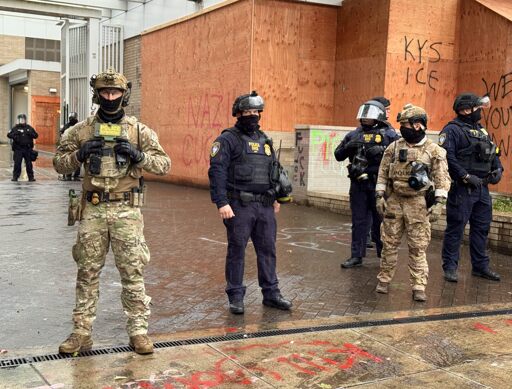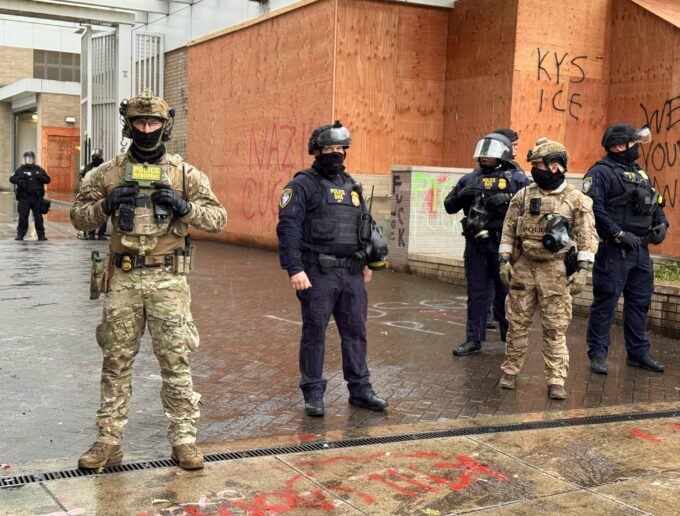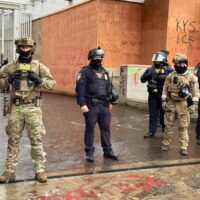Photograph by Nathaniel St. Clair
In the summer of 2020, during the protests in Minneapolis following the brutal murder of George Floyd, Donald Trump and his senior aides discussed the invocation of the Insurrection Act of 1807 in order to deploy active-duty military personnel to quell the unrest. Fortunately, Trump’s most senior advisers—Attorney General William Barr, Secretary of Defense Mark Esper, and Chairman of the Joint Chiefs General Mark Milley—were strongly opposed to sending military personnel to an American city.
There is reason to believe that the invocation of the Insurrection Act is once again on the table in the White House, and there is little likelihood that Attorney General Pam Bondi or Secretary of Defense Pete Hegseth would object; in fact, it is reasonable to assume that Bondi and Hegseth, who are consumed with exaggerated fears of domestic instability, would favor such a move. The unknown in the group, of course, is Chairman of the Joint Chiefs General Dan Caine, who is already facing a great deal of pressure to politicize the professional military.
Trump was furious about the protests in Minneapolis and reportedly wanted to send thousands of active-duty forces to the city. He had significant support from White House aides, presumably led by Stephen Miller, the current deputy chief of staff who is shepherding the harsh domestic crackdown against sanctuary cities and immigrants in general. In June 2020, Trump repeatedly urged General Milley to use the military to confront protesters in Washington, and ranted about the unrest in such cities as New York, Chicago, and Portland. Currently, National Guard troops are in place in Chicago and Portland, where there are no signs of unrest. Trump’s targets are typically blue states where there are mayors of color in key cities.
Secretary of Defense Hegseth’s unprecedented summoning of hundreds of U.S. generals and admirals to Washington to announce the reordering of U.S. military priorities, centering on perceived threats to the homeland, suggests that the Insurrection Act is high on Trump’s agenda. If there is a major power in the world that faces little threat to the homeland, it is the United States. No other major power in the global community can claim the geographic safety and security from oceans to the east and west, and stable border relations to the north and south. The homeland threat is being exaggerated for a reason, and that reason could well include the invocation of the Insurrection Act.
Trump’s highly partisan and bellicose remarks to the assembled generals and admirals called for using America’s “dangerous cities as training grounds for our military.” He painted a picture of the United States under attack “from within,” which could presage the use of the Insurrection Act ultimately. His attacks on Joe Biden were met with silence, unlike his remarks at Ft. Bragg several months ago that elicited anti-Biden boos from American soldiers. Hegseth used the meeting to criticize “fat generals and admirals,” and announced mandatory personal fitness tests on a semi-annual basis.
The loosely worded Insurrection Act of 1807 empowers the president to deploy the U.S. military and to federalize National Guard units of individual states in specific circumstances. It was last used in 1992 to deal with the riots in Los Angeles following the riots that erupted after the acquittal of police officers who had beaten Rodney King. Ironically, the Senate voted 57-43 to convict Trump of inciting insurrection to stop the counting of the votes in January 2021, but the vote was ten votes short of the required two-thirds majority required by the Constitution.
In addition to Trump ordering troops in Portland to use “full force if necessary, there are other worrisome developments. Secretary of Defense Hegseth recently issued a warning to journalists and implemented strict new rules that limit press access to the Pentagon. He warned reporters that the “press does not run the Pentagon—the people do, and that reporters should “wear a badge and follow the rules—or go home.” The Trump’s administration’s current challenges to free speech and free press point to a mindset that could justify invocation of the Insurrection Act.
In recent years, several Democratic senators, including Richard Blumenthal, Alex Padilla, and Adam Schiff, have tried without success to introduce legislation to restrict the president’s broad and vague authority to deploy troops—either with or without the request of a state—to suppress “any insurrection, domestic violence, unlawful combination, or conspiracy.” Harvard Professor Steven Levitsky warned several years ago that American exceptionalism has created a complacency about the strength of the rule of law and constitutional safeguards that are now under attack.
Trump clearly has the ability and the inclination to escalate tensions in U.S. cities, rather than to legitimately restore order. Trump and Hegseth appear driven to politicize the professional military and turn it into a political tool. The fact that major protests are scheduled to take place in cities all over the country in less than three weeks could provide the opportunity that the Trump administration is seeking to deploy more force in U.S. cities. The invocation of the Insurrection Act would allow Donald Trump to act with impunity.
The post Setting the Stage for the Insurrection Act appeared first on CounterPunch.org.
From CounterPunch.org via this RSS feed






